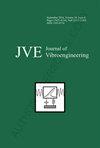利用积分变换技术分析夹紧加劲板振动和能量流的分析模型
IF 0.7
Q4 ENGINEERING, MECHANICAL
引用次数: 0
摘要
基于 Kirchhoff 薄板和 Mindlin 厚板理论,利用有限积分变换法建立的分析模型研究了夹紧加劲板的振动和能量流动特性。结果表明,加劲板在梁/板耦合界面处的能量流动特性取决于肋在板振动模式中的位置。进一步研究了剪切变形和转动惯量对加劲板梁/板耦合界面能量流的影响。研究发现,在模型中加入梁和板的转动惯量只会影响由力矩耦合控制的能量流分量,而不会影响由剪力耦合控制的能量流分量。梁和板的剪切变形主要导致梁远离模态节点线和模态反节点线的模态组的能量流振幅减小,此外,板的剪切变形也导致梁位于模态反节点线的模态组由剪力耦合控制的能量流振幅增大。了解加劲板在梁/板接口处的能量流特性对于有效控制变压器油箱和机器盖板等结构的噪声和振动问题至关重要。本文章由计算机程序翻译,如有差异,请以英文原文为准。
An analytical model for the analysis of vibration and energy flow in a clamped stiffened plate using integral transform technique
Based on Kirchhoff thin plate and Mindlin thick plate theories, the vibration and energy flow characteristics of clamped stiffened plate are studied by using the analytical model constructed by finite integral transform method. The results show that the energy flow characteristics of the stiffened plate at the beam/plate coupling interface depend on the position of the rib in the vibration modes of the plate. The effects of shear deformation and rotatory inertia on the energy flow across the beam/plate coupling interface of the stiffened plate are further investigated. It is found that the inclusion of rotatory inertia of the beam and plate in the model only affects the energy flow component controlled by the moment coupling but not that controlled by the shear force coupling. Whilst the inclusion of the shear deformation of the beam and plate mainly causes a decreased amplitude of the energy flow for the mode group where the beam is located away from both the nodal and antinodal lines of modes, in addition to the shear deformation of the plate which also leads to an increased amplitude of the energy flow component controlled by the shear force coupling for the mode group where the beam locates at the antinodal line of modes. The understanding of energy flow characteristics of the stiffened plate at the beam/plate interface is essential to effectively control the noise and vibration problems of structures such as transformer tanks and machine covers.
求助全文
通过发布文献求助,成功后即可免费获取论文全文。
去求助
来源期刊

Journal of Vibroengineering
工程技术-工程:机械
CiteScore
1.70
自引率
0.00%
发文量
97
审稿时长
4.5 months
期刊介绍:
Journal of VIBROENGINEERING (JVE) ISSN 1392-8716 is a prestigious peer reviewed International Journal specializing in theoretical and practical aspects of Vibration Engineering. It is indexed in ESCI and other major databases. Published every 1.5 months (8 times yearly), the journal attracts attention from the International Engineering Community.
 求助内容:
求助内容: 应助结果提醒方式:
应助结果提醒方式:


